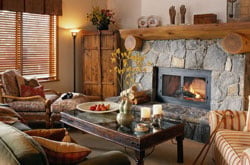Going Green with Fireplaces, Inserts, & Stoves
See if We Have Top-Rated
Green Professionals in Your Area

Fireplaces and wood stoves present some interesting dilemmas when it comes to going green in your home. While wood is a far more renewable resource than the various forms of fossil fuels used to heat the majority of American homes, burning wood for heat releases higher levels of pollution into the air, can present a serious health risk to homeowners by compromising indoor air quality, and it can be a dramatic source of heat loss in your home. Thus, green fireplaces are rarely wood-burning, while green stoves are primarily concerned with energy-efficiency.
The Cost and Value of Green Fireplaces and Stoves
HomeAdvisor understands that it can be tough for homeowners to wade through all the "green" remodeling information out there, which is why we've teamed up with green remodeling expert David Johnston to provide you with the best, most accurate, green remodeling advice in the business. Johnston is the founder of the green consulting firm What's Working, Inc., the author of multiple books on green remodeling (including the Nautilus Award winner Green Remodeling: Changing the World One Room at a Time), and he happens to know a thing or two about how to green fireplaces and stoves.
With green stoves and fireplaces, you'll rarely end up paying more than you would for traditional alternatives, and you'll usually end up saving money in the long run. How? If you heat with wood, purchasing a high-efficiency pellet stove or an EPA-certified wood burning stove will reduce the fuel you need to burn to heat your home and will heat your home more efficiently in the process. Even then, when it comes to cost, the real value of going green with fireplaces and stoves isn't necessarily best expressed by scrutinizing your bottom line. Green fireplaces and stoves come with bigger and better benefits, including a healthier home environment for everyone that lives under your roof and the peace of mind that goes hand-in-hand with knowing that you're doing everything you can to pass a better world on to future generations.
Tips for Green Fireplaces
- Avoid Wood Burning Fireplaces—According to Johnston, a wood burning fire exhausts as much as 24,000 cubic feet of air per hour out of the chimney, all of which is replaced by cold air from outside that must then be heated by your furnace or boiler. By installing an alternative fireplace option, such as a gas fireplace insert, you can eliminate a major source of energy inefficiency in your home.
- Look Into Tax Benefits and High-Efficiency Upgrades—Many states offer tax incentives to homeowners who upgrade to high-efficiency units.
- High Efficiency = Environmentally Friendly—Fortunately for the environment, a high-efficiency fireplace or stove is also a more environmentally friendly one. High-efficiency models convert a higher percentage of fuel to heat, which in turn creates less exhaust (or smoke) that is released into the atmosphere. Many high-efficiency units also have catalytic converters that further reduce the pollution exhausted into the atmosphere.
Don't get left in the cold! Use this link to
Install a FireplaceTips for Green Stoves
- Install a Pellet Stove—If you're not completely committed to burning solid wood as a fuel, consider installing a high-efficiency pellet stove that burns small cylinders made from compressed sawdust. Pellet stoves produce fewer pollutants than wood burning stoves, utilize a byproduct of the lumber industry that would otherwise be discarded as waste, and are far more efficient than traditional wood-burning stove designs, thanks to an electronically regulated mix of fuel and air that promotes optimum burning efficiency.
- Install an EPA Certified Wood Stove—EPA certified wood stoves emit 70 to 90 percent less particulates into the air than conventional wood stoves. That equates to huge health benefits for you and yours, seeing as how EPA studies indicate that exposure to wood smoke is just as harmful as being exposed to an equal amount of cigarette smoke in an indoor environment.
- Properly Size Your Stove—Just as with fossil fuel burning furnaces and boilers, it's important that your contractor installs the properly sized stove for your home. A properly sized wood burning or pellet stove will burn fuel more efficiently and heat your home more comfortably than one that is too large or too small for the space you are dealing with.
- Purchase a Unit that Draws Combustion Air From Outdoors—Whether you're burning natural gas, pellets, or wood, it pays to purchase a high-efficiency unit that draws combustion air in from the outdoors. By doing so, you won't be wasting already heated indoor air to fuel the fire.
Final Thoughts for Green Stoves and Fireplaces
While thinking green when it comes to stoves and fireplaces is a smart choice for your pocketbook, your health, and the environment, it's not unusual for homeowners to feel a little overwhelmed when presented with the full scope of green remodeling options. If you're feeling unsure about how green you're willing to go when it comes to stoves and fireplaces, there's no need to worry. Going green is not an all-or-nothing proposition, and any step you take in a green direction is a smart one. If you think green is the right choice for you, talk with your contractor about adopting a green remodeling philosophy, find a contractor who specializes in green building and remodeling, or seek out the services of a green consulting firm so you can be sure that your new stove or fireplace ends up being as green as they come.

